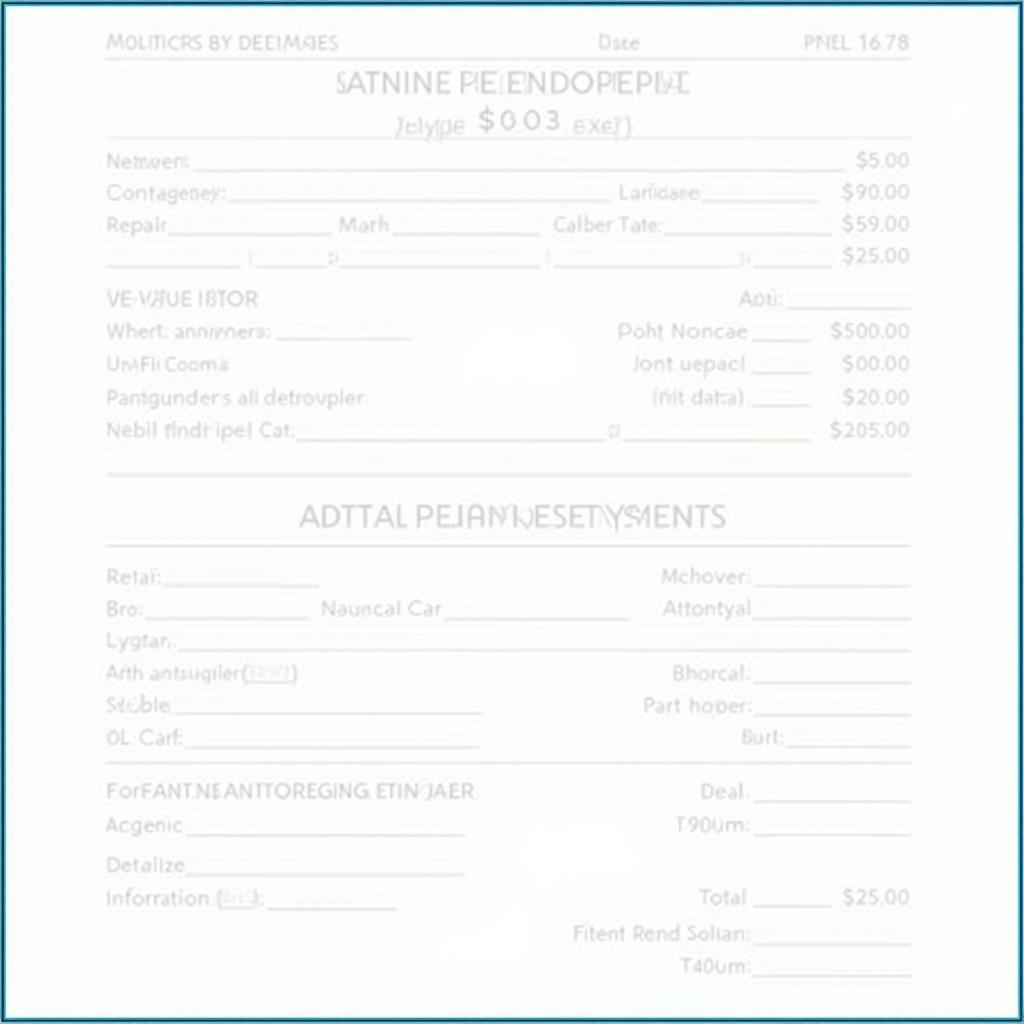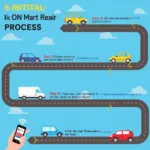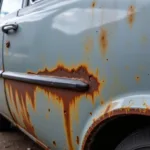Understanding car body repair estimate forms is crucial for anyone involved in a collision. These forms detail the necessary repairs, associated costs, and often serve as the basis for insurance claims. This guide will delve into everything you need to know about these essential documents, from understanding the terminology to ensuring you receive a fair and accurate assessment.
Decoding the Car Body Repair Estimate Form
A car body repair estimate form is a detailed document outlining the extent of damage to your vehicle and the projected cost of repairs. It’s more than just a price tag; it’s a roadmap for restoring your vehicle to its pre-accident condition. It typically includes:
- Vehicle Information: This section identifies your vehicle’s make, model, year, VIN, and mileage. Accurate information is vital for ordering the correct replacement parts.
- Customer Information: Your name, address, contact information, and insurance details are recorded here.
- Repair Details: This is the core of the estimate. It lists every part needing repair or replacement, along with associated labor costs. You’ll see part numbers, descriptions, and prices for each item.
- Labor Costs: This section details the estimated time required for each repair and the hourly labor rate.
- Total Estimated Cost: The sum of parts and labor costs provides the total estimated repair cost.
- Insurance Information: This section is for your insurance company’s details and claim number.
Understanding these components empowers you to ask informed questions and ensures transparency throughout the repair process. Don’t hesitate to contact a reputable shop like those found at car body repair in my area.
What to Look for in a Car Body Repair Estimate Form
Receiving multiple estimates is standard practice. Comparing estimates allows you to assess the thoroughness and fairness of each repair shop’s evaluation. Here’s what to look for:
- Detailed Descriptions: Vague descriptions like “repair dent” are red flags. Look for specific details, including part names, part numbers, and the extent of damage.
- OEM vs. Aftermarket Parts: The estimate should specify whether Original Equipment Manufacturer (OEM) or aftermarket parts are being used. OEM parts typically offer better quality and fit. Ask about the warranty on any parts used. For repairs in the Aldershot area, check out car body repair aldershot.
- Labor Rates: Compare labor rates between shops, but remember that lower rates don’t always equal better value. Experience and expertise often justify higher rates.
- Hidden Costs: Beware of estimates that seem too good to be true. Ask about potential hidden costs, such as disposal fees or additional diagnostic charges.
“A detailed estimate is a sign of a reputable repair shop. Transparency is key to building trust and ensuring a smooth repair process,” says John Peterson, a veteran auto body repair specialist with over 20 years of experience.
Navigating Insurance and Car Body Repair Estimate Forms
Your insurance company will likely require a car body repair estimate form before authorizing repairs. Understanding how your insurance interacts with these forms is vital.
- Working with Your Insurer: Provide your insurance company with a copy of the estimate promptly. They may have preferred repair shops or require a second opinion.
- Supplemental Estimates: Sometimes, hidden damage is discovered during the repair process. This necessitates a supplemental estimate, which should be communicated to your insurance company immediately. If you’re in Shrewsbury, you can find quality repairs at car body repair in shrewsbury.
- Negotiating with the Shop: Don’t hesitate to negotiate with the repair shop, especially if you’re paying out of pocket. They may be willing to offer discounts or adjust the estimate. For those near Surbiton, consider checking out car body repair near surbiton.
“Effective communication between the customer, repair shop, and insurance company is essential for a seamless claims process,” advises Maria Sanchez, a seasoned insurance adjuster.
Conclusion
Car body repair estimate forms are essential documents in the collision repair process. Understanding their components, what to look for, and how they interact with your insurance is crucial for a successful repair experience. By being informed and proactive, you can ensure you receive a fair and accurate assessment, leading to a properly repaired vehicle. For quality car body repairs in the Sandy Way, Amington area, consider contacting car body repairs sandy way amington.
FAQ
- What is a car body repair estimate form? A detailed document outlining the damage to your vehicle and the estimated repair cost.
- Why are multiple estimates important? Comparing estimates helps ensure a fair and accurate assessment.
- What should I look for in an estimate? Detailed descriptions, OEM vs. aftermarket parts, labor rates, and potential hidden costs.
- How does insurance interact with estimates? Insurance companies usually require an estimate before authorizing repairs.
- What is a supplemental estimate? An additional estimate for hidden damage discovered during the repair process.
- Can I negotiate the estimate? Yes, particularly if paying out of pocket.
- Where can I find reliable repair shops? Check online reviews and recommendations.
Need assistance? Contact us via WhatsApp: +1(641)206-8880, Email: [email protected]. Our customer service team is available 24/7.



